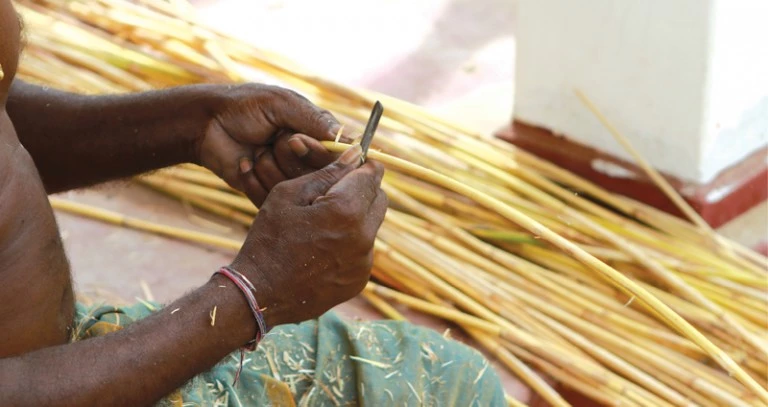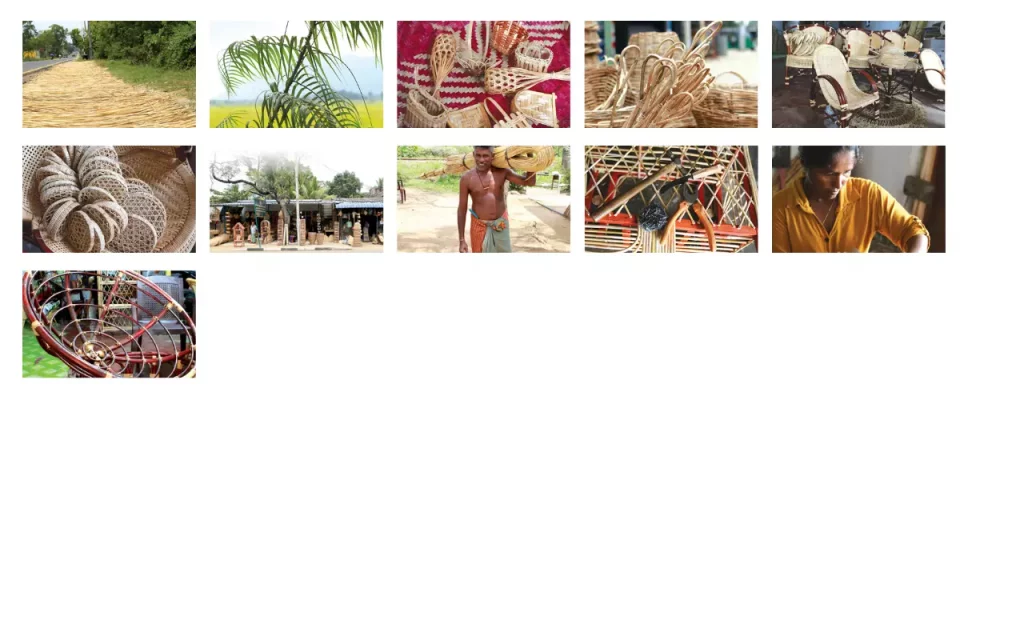
Along the road to Batticaloa is the village of Manampitiya. Laid out to dry on either side of the scorching road are long stems of cane, symbols of an ancient industry striving to survive.
Words Keshini de Silva | Photographs Vishwathan Tharmakulasingham and Anuradha Perera

A bunch of us crossed the Mahaweli River over the famed old railway bridge depicted on Sri Lanka’s 50 rupee note and entered the village of Manampitiya, shrouded in greenery. Large vehicles went back and forth transporting sand and other raw materials for construction, yet further into the village, the setting was serene. Rows of cane laid out along the road to dry under the sweltering afternoon sun led us to a simple house where cane was being split, bent, twisted and knotted.
The skill of bending the pliable cane into eco-friendly furniture and utensils is an ancient one, passed down the generations in certain villagers in Sri Lanka, especially in the east of the Island. Due to the growth in plastic and fibre goods, however, it is now a fast disappearing industry. In Manampitiya, like most places in the Polonnaruwa district, sourcing raw material for the cane industry used to be a popular source of income. Until the more lucrative business of supplying raw materials for the construction industry took off, that is.
Today only a handful of families engage in wewel, or cane production and retail. The types of cane used are kukul wewel – the thinner cane used for weaving and intricate crafts – and ma wewel – the thicker and stronger cane used to form the bases of items of furniture.
Dharmapala Madawala, who was a mere teenager when he launched his workshop, acted as our guide to cane production in the local area. He showed us cane bushes in paddy fields and in patches along the roadside, but it is in the forests that border the village that the bulk of the cane grows. Cutting cane in the forest is an arduous and risky business, but many endure the hardships associated with it as it is their only means of livelihood. Serpents inhabit the cane bushes and wild elephants roam the woodlands in search of food, so the probability of a confrontation with a cane-cutting villager is high. Although classified as a bush, cane plants grow to be quite tall and dense, are usually located in muddy groves, and are extremely thorny. As a result, villagers must approach the bushes with great care to avoid getting scraped.
So skilled are Sri Lanka’s cane craftsmen that they even craft miniature baskets and boxes to be used as wedding cake casings
A hook is used to pull the stalks towards the cane-cutter from a distance, who then uses a sharp knife to cut through the stem in one whack. All in one go, the leaves are peeled off with the knife and the stems are stacked up to be bundled and carried back to the village on foot. Here they are sold to local cane manufacturers or transported westwards to Weweldeniya.
As cane is not commercially cultivated in Sri Lanka, there is a shortage in raw material for the cane industry, as it must depend on cane that grows in the wild. The more expansive producers usually import from Malaysia, while the others must simply make do with the little that grows here. According to Dharmapala however, Malaysian cane is not popular as it is not as sturdy as cane grown on the Island.
The next step is to dry the cane, which is why you’ll see so much of it laid out on the side of the searing Maradankadawala-Habarana-Thirukkondaiadimadu Highway. Cane can last for eons as long as it is not soaked in water (because moisture rots the pith of the cane), at any stage along the harvest or drying process.
Although classified as a bush, cane plants grow to be quite tall and dense, are usually located in muddy groves, and are extremely thorny
Upali Premathilake sat on the floor before us, niftily splitting the bark from the pith of a piece of cane. The bark was then scrupulously stacked away in a dry place, while the pith was stored separately. It’s of little use due to its lack of strength and durability but can be made into disposable items such as the daranduwa, a cane coil on which hot pots taken off the stove are left to cool.
The bark, on the other hand, is used to weave wicker baskets, chairs, cupboards and racks. It’s even bent to create walking sticks or cane rods, used by parents and teachers to instill discipline in young ones. Furniture is usually lacquered or painted to give it less of a rustic feel and a better finish, as well as enhance its durability.
So skilled are Sri Lanka’s cane craftsmen that they even craft miniature baskets and boxes to be used as wedding cake casings.
Despite the natural growth of cane and decades-old craftsmanship in Manampitiya, we found few shops that sold cane goods in the village. Most of the goods are transported to Weweldeniya in the Gampaha District, the popular cane goods distribution centre, where manufacturers either have their own shops or provide goods to other retail operations. Ironically, although the name of the town derives from wewel, cane does not grow there. Weweldeniya, in fact, used to be called Radawadunna, and its name is thought to have been changed to reflect its role in the cane industry. Raw cane and cane goods are usually transported from Anuradhapura, Polonnaruwa, Mannar and Ampara, and Dharmapala too is a supplier of cane to Weweldeniya. However, raw material shortages are an issue that he has real concerns about, he told us.
Manampitiya is quaint, lacking the animated sounds of workmanship that you hear in Weweldeniya. But make no mistake, whether within the forest or in huts in the village, the fight against the extinction of the cane industry goes on.



